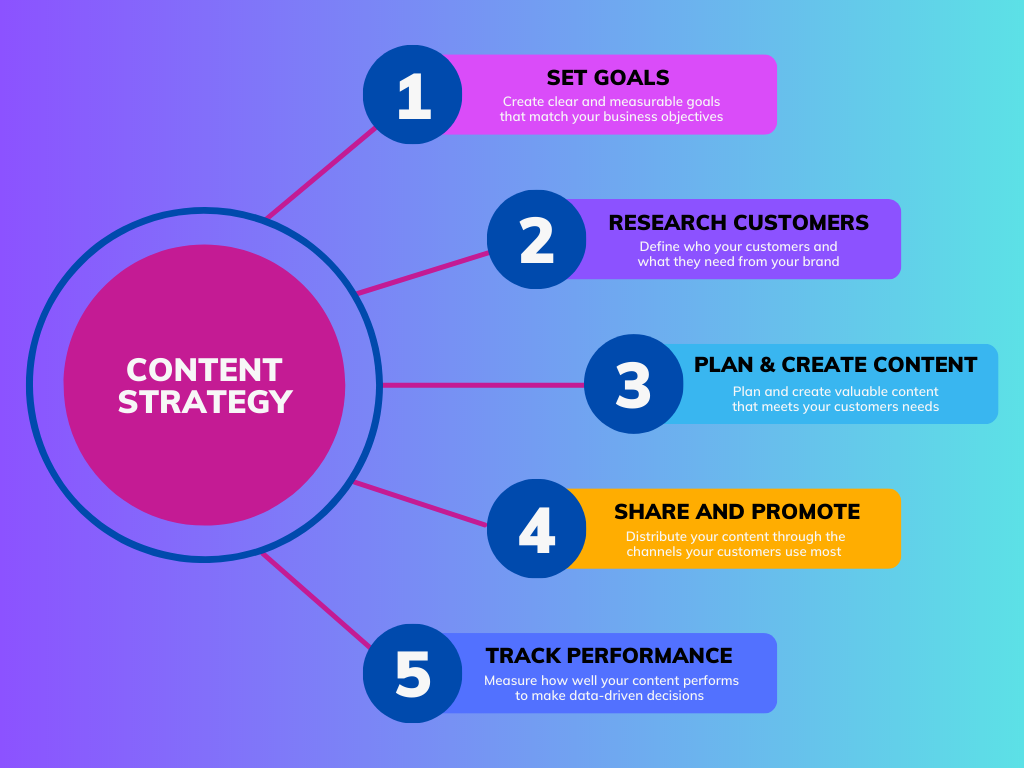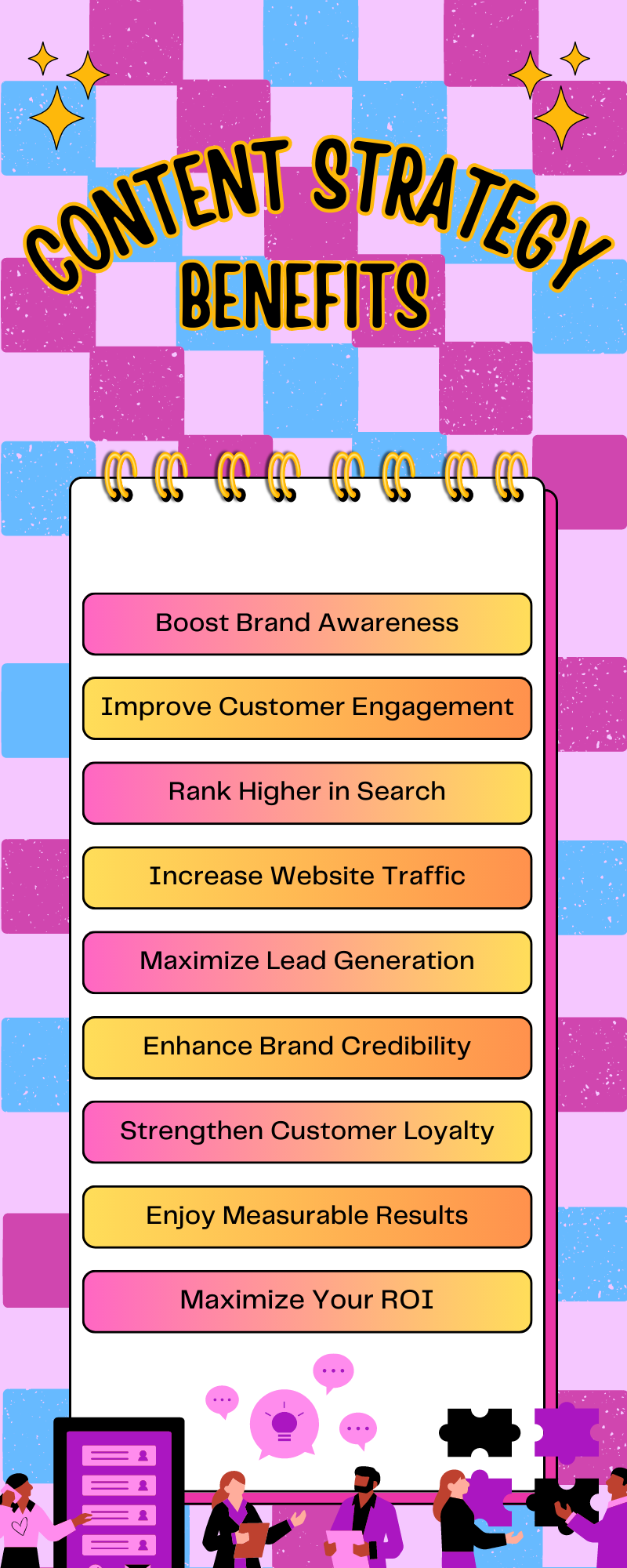
More than 80% of people research a business online before buying a product or service. And by 2040, e-commerce will play a role in at least 95% of purchases. Will your company appear in the search results as people research your products and services? If not, you have some work to do, for sure.
In today’s digital world, having a strong online presence is really important for businesses to do well. But you must have a game plan, or your efforts could fall flat. That’s where a successful content strategy comes in. It’s a content marketing plan that helps businesses share their message, connect with their audience, and reach their goals.
Want to learn more? Here’s what you need to know about content strategy and why your business needs one.
Table of Contents
- First Things First, What is Content Marketing Strategy?
- Key Elements of an Effective Content Strategy
- Why Your Business Needs a Content Strategy
- 7 Steps to Develop a Winning Content Strategy
- Content Strategy Case Study Examples
First Things First, What is Content Marketing Strategy?
Content strategy is a big plan that explains how content will be made, organized, and shared to meet your business goals. All its parts work together to ensure the works match your brand voice, are relevant to your customers’ interests, and perform well.
Key Elements of an Effective Content Strategy

A high-performance content strategy has five main parts:
Setting Goals
Creating your strategy starts with setting clear and measurable goals that match your business objectives. These goals can be things like:
- Helping more people learn about your company
- Bringing more people to your website
- Getting more qualified leads
- Encouraging customers to interact with your brand more
You don’t have to stick with your initial goals throughout the life of your business. You can change them annually or even quarterly to keep pushing your company forward.
Knowing Your Audience
To make good content, it’s important to know who your target audience is. This means doing research to understand things like their:
- Age
- Location
- Interests
- What they like
- What problems they want to solve
- How they like to shop
There are two main ways to define your audience: buyer personas and jobs to be done.
Buyer personas are fictional representations of your target audience.
Jobs to Be Done is a framework that helps you understand the needs and motivations of your customers as they consider buying your products or services.
For the best results, use both methods to fully understand who your customer is and what they need from your brand.
Planning and Making Content
The overarching goal for any good content strategy is for people to recognize your brand as the go-to source for information about your industry’s products and services. And it all comes down to the works you create, like:
- Blog posts
- Social media posts
- Case studies
- Whitepapers
- e-Books
- Newsletters
- Videos
- Infographics
- Slide decks
- Emails
- Online courses
To make the biggest impact, your strategy should also define how to write or talk to make sure the content fits with your brand mission, vision, and values. You’ll also need to research what keywords to target to make your pages appear in more search results and rank higher.
Sharing and Promoting Content
Now, you must decide where, how, and when to share your works. You need to distribute your content through the channels your target audience prefers to make it easy to find and enjoy.
In short, make sure your content meets your customers where they’re at online, such as:
- Your website
- Social media
- Video-sharing platforms
- Industry-specific forums
- Online magazines
- Virtual events
Your strategy should find a balance between reaching many people and not bothering them too much with unwanted messages.
Measuring and Analyzing
Are your works reaching the right people and making a positive impact?
To figure that out, you have to measure how well the content is doing on a set schedule. This helps you see if it’s working or if changes need to be made.
As you make decisions based on the data, you can dial in the content types, distribution channels, and messaging to better connect with your target audience and reach your goals.
Why Your Business Needs a Content Strategy

Although you can throw it all at the wall and see what sticks, having a game plan is better. When you have a clear plan, you can make smart and focused choices that help you work efficiently and have a better chance of achieving what you want.
The benefits you can enjoy by taking this step include:
Boost Brand Awareness
Targeted content helps you reach a wider audience, making your brand more visible and improving your chances of becoming a household name.
Improve Customer Engagement
Delivering the right content at all the right times helps you connect with your customers on a deeper level and foster meaningful interactions.
Rank Higher in Search
Matching your content to search intent for your selected keywords helps your pages show up higher in search results pages, boosting organic traffic.
Increase Website Traffic
Creating and sharing valuable content attracts more visitors to your website overall and further improves your online visibility.
Maximize Lead Generation
Well-crafted content helps capture the interest of potential customers and generates qualified leads for your sales team.
Enhance Brand Credibility
When well-planned and executed, your content can help establish your brand as an authority in your industry and build trust with your audience.
Strengthen Customer Loyalty
By consistently delivering valuable content, it’s easier to keep existing customers engaged and increase their loyalty to your brand.
Enjoy Measurable Results
A defined strategy allows you to track and measure the performance of your content, so you can make well-informed, data-driven decisions on how to improve.
Maximize Your Return on Investment
Your content strategy allows you to stick to your marketing budget without compromising on results, helping maximize your return on investment.
7 Steps to Develop a Winning Content Strategy

You’re only seven steps away from creating a winning content strategy for your brand. Here’s how to approach this important process.
1. Set Clear and Measurable Goals
A successful strategy starts with making SMART goals for your marketing program.
SMART stands for:
- Specific
- Measurable
- Achievable
- Relevant
- Time Bound
Using the SMART framework helps you ensure that you have clear, reasonable goals that align with your business objectives and can be completed in a certain time frame.
Examples of SMART goals for your initial digital marketing campaign are:
- Increase website traffic by 20% within the first three months.
- Generate 100 new leads through content downloads within the first month.
- Increase social media engagement by 50% by the end of the campaign.
- Increase brand awareness by reaching 10,000 new unique visitors to the website within the first two months.
- Obtain 50 backlinks from authoritative websites within the first three months.
- Increase email newsletter subscribers by 25% by the end of the campaign.
- Generate $10,000 in revenue directly attributed to content-driven conversions within the first month.
- Improve search engine ranking for targeted keywords, reaching the first page of search results within six months.
You can just use one goal or choose several. Just remember that you need to give your campaign time to work. That way, you can gather the performance data needed to adjust your approach and goals.
2. Complete Audience Research and Analysis
Audience research and analysis come next. You can only create valuable content for your customers if you know who they are and what they aim to accomplish by buying your products and services.
Start by creating a buyer persona that represents your biggest customer base. You can have more than one buyer persona for your brand if you have multiple customer segments. For each one, research their demographics, behaviors, interests, needs, and preferences to build their profile.
Move on to defining jobs to be done to get the full picture of what your customers need from your brand. Think about what pain points drive people to purchase your products and services. What issues are they trying to solve? What do they stand to gain by completing their purchase?
3. Select Your Content Formats and Channels
With your audience research complete, you can move on to selecting your content formats and channels. Use your research to determine what types of content your customers prefer most and where they spend their time online.
This looks different for every business, although your methods will likely align with your competitors’. If busy professionals who prefer easily digestible information are your target audience, you might consider creating short and informative videos and sharing them on YouTube or LinkedIn.
On the other hand, an audience that enjoys in-depth analysis and insights will likely prefer long-form blog articles or whitepapers. To get those works in front of them, you can host them on your website, deliver them as email newsletters, or share on industry forums.
4. Create a Content Calendar and Plan
Create a calendar next to stay organized and consistent with your content creation and distribution. You will need to plan themes and topics based on your customers’ needs and preferences.
For example, if you have an educational platform targeting students, your content calendar can be structured around academic milestones and exam periods. You can plan themes like “Study Tips for Finals Week” or “Effective Time Management Strategies” and develop topics like “How to Improve Your Note-Taking Skills” or “The Benefits of Creating a Study Schedule.”
For a pet care blog, your calendar could include themes like “Pet Health and Wellness” or “Training Tips and Tricks.” Under each theme, you can plan specific topics such as “How to Choose the Right Dog Food” or “Effective Ways to House Train Your Puppy.”
5. Implement SEO Best Practices
If you want to improve your brand’s visibility in search, it’s time to implement SEO best practices. The process starts with keyword research using tools like:
- Moz
- SpyFu
- Semrush
- Answer The Public
- Google Keyword Planner
- WordStream
- Ahrefs
Create a spreadsheet of all the keywords your customers will likely use to find your brand and products or services. Consider organizing them into pillars that match your products and services. Research the keywords to identify their search intent and see how well the top-ranking pages cover the topic.
Your goal? Write the best page on the internet about that topic.
Within your content, naturally use the target keyword and its semantic equivalents. Also, put the main keyword in your headers and meta tags to help web crawlers understand what your page is all about and rank it accordingly.
Quick Note: Although they can help your SEO efforts, image alt tags are for accessibility, first and foremost. So, skip shoehorning the keywords into your works. Instead, create your alt image text while focusing on clearly and accurately describing the image. That way, screen readers can easily relay that information to their users.
6. Establish Content Creation and Distribution Workflows
Establish your SEO content creation and distribution workflows next to keep your marketing campaign on track from start to finish. You must define clear roles, responsibilities, and processes for creating, editing, and publishing your works.
If you’re doing it all yourself, then this part is easy. But if you want to work with a team, collaboration and communication will make all the difference in how well your marketing efforts pan out.
Take the time to determine who will write the content, how they’ll approach the creation process, and when they’ll need to complete each item. Then, do the same for those in charge of editing and distributing on the set schedule.
7. Define Metrics and Measurement Tools
Measuring the performance of your content is key to consistently reaching your goals and pushing your marketing to the next level. To do that effectively, you have to determine which key performance indicators to track and measure, such as:
- Website traffic: The number of visitors your content attracts to your website.
- Time on page: The average amount of time visitors spend on your pages, indicating their level of engagement.
- Bounce rate: The percentage of visitors who leave your website after viewing only one page, reflecting how well your works capture their interest.
- Conversion rates: The percentage of visitors who take a desired action, such as making a purchase or subscribing to a newsletter.
- Lead generation: The number of leads generated through your content, such as form submissions or email sign-ups.
Also, think about what measurement tools you want to use. Google Analytics is the most common for measuring website performance, but you can also use Moz Pro, Semrush, or Ahrefs.
Want to track your marketing performance on social media? Each platform has its own performance tracking tools you can use.
Content Strategy Case Study Examples

Here are two examples of how an effective content strategy can improve marketing success.
Company A
Company A created a plan to increase brand awareness. They wanted to be seen as experts in their industry and build a strong brand identity.
The marketing team focused on reaching a professional audience, including industry experts, potential customers, and influencers, using long-form blogs and podcasts. They aimed to distribute content through their website, social media, and industry blogs.
Key Results and Impact
Company A’s strategy worked well. They saw a big increase in website visitors, especially from people searching online. Their social media pages got more attention, leading to more people mentioning their brand, following them, and engaging with their posts.
Brand awareness grew a lot. Company A became known and remembered by its target audience. People trusted them for industry information and became loyal followers.
Their strategy also improved their search engine rankings. By consistently creating high-quality content, Company A showed up higher in more search result pages for industry-related keywords.
Summary
Overall, Company A’s content strategy was a success. It established them as a respected industry leader, making their brand stronger and reaching more of their desired audience. This increased brand awareness improved how customers saw the company, building trust and opening doors for future growth and success.
Company Z
Company Z developed a strategy focused on generating leads. They aimed to attract potential customers, engage them with valuable content, and convert them into qualified leads. The strategy utilized various content types, such as blog posts, email newsletters, and gated landing pages for e-book downloads.
Key Results and Impact
Company Z’s strategy for lead generation was successful. They experienced a significant increase in leads generated through their digital marketing efforts. By providing valuable content, they captured the interest of their target audience and encouraged them to take action, such as signing up for newsletters or downloading gated works.
The strategy had a substantial impact on the sales pipeline. The leads generated through the strategy were nurtured and guided through the sales funnel, resulting in a higher conversion rate. The content played a vital role in building trust, addressing customer pain points, and showcasing the value of Company Z’s products or services.
The effective content strategy led to noticeable revenue growth for Company Z. The increased number of qualified leads and improved conversion rates directly contributed to higher sales and revenue generation. The strategy proved to be a cost-effective lead generation method, providing a positive return on investment.
Summary
Company Z’s strategy successfully attracted and converted leads, impacting its sales pipeline and revenue growth. They built trust, established authority, and achieved meaningful business outcomes by delivering tailored and valuable content.
Challenges in Content Strategy Implementation
There are many challenges standing in the way of businesses like yours implementing a successful content strategy, such as:
- Content overload: The digital landscape offers a never-ending flow of content, making it difficult to stand out against the competition.
- Resource Constraints: Budget, human capital, and time limitations can get in the way of using an effective content strategy to achieve your marketing goals.
- Evolving Trends: The constant influx of emerging trends and evolving audience preferences demand that you keep your ear to the ground and make changes on the fly to keep up.
- SEO Updates: Google constantly refines its algorithms to improve the user experience, making your website a living, breathing entity that needs constant care.
If you want to implement a successful content strategy for your brand, you’ll need to address all these challenges on an ongoing basis.
Ready to Create Your Content Strategy with Jetura Media?
Creating and implementing a content strategy can help your brand grow, build customer loyalty, and stand out from the crowd. You’ll have an easier time adapting to changes and staying relevant in a competitive digital world.
That’s why our team at Jetura Media encourages businesses like yours to embrace content strategy as an essential part of their marketing plan. If you’d like help creating your plan, please fill out our online content strategy request form, and we’ll be in touch.
